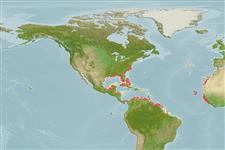Classification / Names
Common names from other countries
Main reference
Size / Weight / Age
Max length : 213 cm WD male/unsexed; (Ref. 4441); common length : 120 cm WD male/unsexed; (Ref. 5217)
Length at first maturity
Lm ?, range 61 - 71 cm
Environment
Marine; brackish; benthopelagic; oceanodromous (Ref. 51243); depth range 0 - 22 m (Ref. 26912)
Climate / Range
Tropical, preferred ?; 42°N - 1°S, 99°W - 12°W (Ref. 55259)
Distribution
Eastern Atlantic: Mauritania, Senegal and Guinea. Western Atlantic: southern New England to northern Florida (USA) and throughout the Gulf of Mexico, migrating to Trinidad, Venezuela, Brazil and Uruguay (Ref. 7251).
Countries | FAO areas | Ecosystems | Occurrences | Introductions
Short description
Deep grove around front of head below eyes; forehead above groove indented, snout below groove is distinctly bilobed (Ref. 26938). Disk brown to olive above, with no spots or marks, wings long and pointed (Ref. 7251). Lower surface white or yellowish white (Ref. 6902).
IUCN Red List Status (Ref. 115185)
Threat to humans
Traumatogenic (Ref. 4690)
Human uses
Fisheries: minor commercial; aquarium: public aquariums
More information
Age/SizeGrowthLength-weightLength-lengthLength-frequenciesMorphometricsMorphologyLarvaeLarval dynamicsRecruitmentAbundance
ReferencesAquacultureAquaculture profileStrainsGeneticsAllele frequenciesHeritabilityDiseasesProcessingMass conversion
Tools
Special reports
Download XML
Internet sources
Estimates of some properties based on models
Phylogenetic diversity index
PD50 = 0.5039 many relatives (e.g. carps) 0.5 - 2.0 few relatives (e.g. lungfishes)
Trophic Level
3.2 ±0.0 se; Based on diet studies.
Resilience
Low, minimum population doubling time 4.5 - 14 years (Fec assumed to be <100)
Vulnerability
High vulnerability (57 of 100)
Price category
